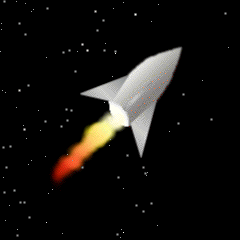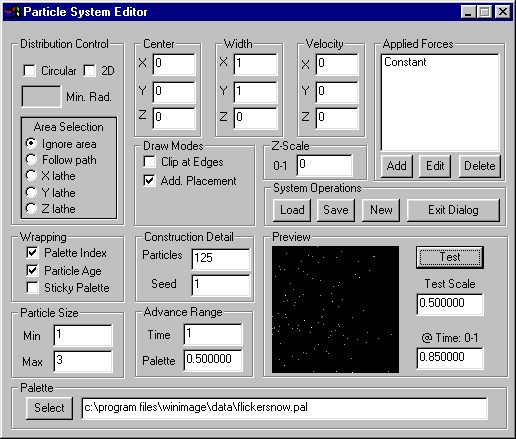
|
| Quick Nav Bar | ||||||||
|---|---|---|---|---|---|---|---|---|
| << Previous | Contents |
Selection |
Op Index |
Parent | User Notes |
Index |
Glossary |
Next >> |

|
|
Particle Definition |
| Using 100 relatively large particles (8), we set up a center position to match the cheesy little rocket's tail and an initial distribution over the direction we want the rocket exhaust to go. We use additive placement because this is a light effect. We wrap the particles age so that when they end, they snap back to the beginning location. The time advance is 1, so that the particles are spread out all over the system's lifetime - some are just starting when others are in the middle, and so on for the whole time span. |
Force 1 |
| This force is constant - meaning, it doesn't accellerate. The particles just move along at the velocity specified at all times in a linear fashion. |
Force 2 |
| This force has no velocity, its function is to carry the fade multiplier in isolation. The intent is to make the rocket flame fade out at the end, which works just fine. Particles begin to fade 1/4 of the way from the rocket, and are gone by the end of the system lifetime. |
Palette |
| This is a classic "flame palette". The colors here describe the temperature of a flame. Really hot is white... then yellow... then red.... then black. We don't need black, because we used the second force to fade the flame out, which did the same thing on a black background, even better in the case of something that is utterly consumed in the burning. If there was ash in the exhaust, for instance, you'd need the black color. You also might want to put blue in there between white and yellow; it depends on what is supposed to be burning. Many types of metals tend to burn blue before yellow. Other flame palettes can include green (copper burns green) and bright red (sodium burns red) and so on. |
Particle Definition |
| 125 little particles for stars, distributed evenly over the entire image in X and Y using the width control. Time advance is one so that they have lifespans all over the system lifetime, and a palette advance of .5 so that they work through the "twinkle" colors at different times. (Yes, we know that stars wouldn't twinkle in space, but the idea was to show you how to do it... :-P) |
Force 1 |
| This applies a constant diagonal velocity so the stars appear to be streaming by the spaceship. |
Palette |
| Star colors, with twinkle highlights. |
| Quick Nav Bar | ||||||||
|---|---|---|---|---|---|---|---|---|
| << Previous | Contents |
Selection |
Op Index |
Parent | User Notes |
Index |
Glossary |
Next >> |
| WinImages F/x Manual Version 7, Revision 5, Level B |